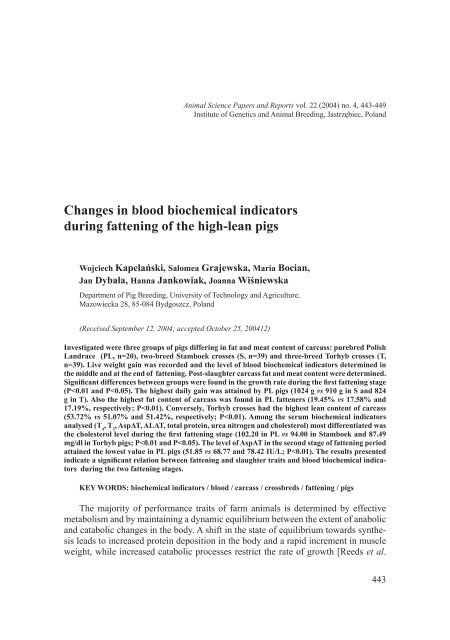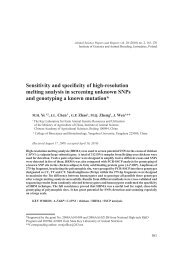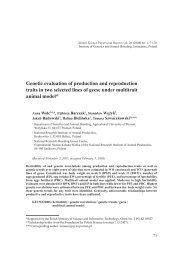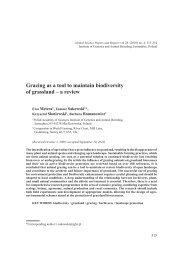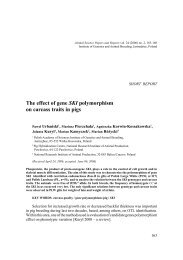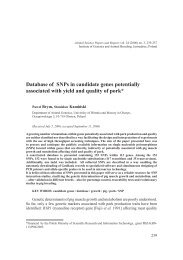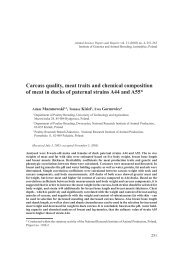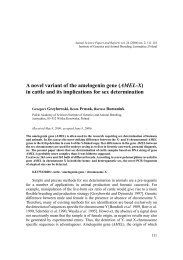Changes in blood biochemical - Instytut Genetyki i Hodowli ZwierzÄ t ...
Changes in blood biochemical - Instytut Genetyki i Hodowli ZwierzÄ t ...
Changes in blood biochemical - Instytut Genetyki i Hodowli ZwierzÄ t ...
Create successful ePaper yourself
Turn your PDF publications into a flip-book with our unique Google optimized e-Paper software.
Animal Science Papers and Reports vol. 22 (2004) no. 4, 443-449<br />
Institute of Genetics and Animal Breed<strong>in</strong>g, Jastrzębiec, Poland<br />
<strong>Changes</strong> <strong>in</strong> <strong>blood</strong> <strong>biochemical</strong> <strong>in</strong>dicators<br />
dur<strong>in</strong>g fatten<strong>in</strong>g of the high-lean pigs<br />
Wojciech Kapelański, Salomea Grajewska, Maria Bocian,<br />
Jan Dybała, Hanna Jankowiak, Joanna Wiśniewska<br />
Department of Pig Breed<strong>in</strong>g, University of Technology and Agriculture,<br />
Mazowiecka 28, 85-084 Bydgoszcz, Poland<br />
(Received September 12, 2004; accepted October 25, 200412)<br />
Investigated were three groups of pigs differ<strong>in</strong>g <strong>in</strong> fat and meat content of carcass: purebred Polish<br />
Landrace (PL, n=20), two-breed Stamboek crosses (S, n=39) and three-breed Torhyb crosses (T,<br />
n=39). Live weight ga<strong>in</strong> was recorded and the level of <strong>blood</strong> <strong>biochemical</strong> <strong>in</strong>dicators determ<strong>in</strong>ed <strong>in</strong><br />
the middle and at the end of fatten<strong>in</strong>g. Post-slaughter carcass fat and meat content were determ<strong>in</strong>ed.<br />
Significant differences between groups were found <strong>in</strong> the growth rate dur<strong>in</strong>g the first fatten<strong>in</strong>g stage<br />
(P
W. Kapelański et al.<br />
1980, Skjaerlund et al. 1994, Lobley 1997].<br />
Essential to the growth and development of pigs are the thyroid hormones thyrox<strong>in</strong>e<br />
and triiodothyron<strong>in</strong>e, which are the ma<strong>in</strong> regulators of metabolism [van Hardeveld<br />
1992] and also regulate lipid metabolism <strong>in</strong> the body [Migdał et al. 2003]. The <strong>in</strong>tensity<br />
of metabolic changes, ma<strong>in</strong>ly of prote<strong>in</strong>, is also reflected <strong>in</strong> the concentration of other<br />
<strong>biochemical</strong> <strong>in</strong>dicators of <strong>blood</strong>, such as total prote<strong>in</strong>, urea, aspartate am<strong>in</strong>otransferase<br />
or alan<strong>in</strong>e am<strong>in</strong>otransferase [Falkenberg et al. 1997, Kapelański et al. 2000, Więcek<br />
and Skomiał 2000]. Also cholesterol is a major component <strong>in</strong>tegral to the morphological<br />
and subcellular structure of the muscle as a natural component of cell membranes<br />
[Hoelscher et al. 1988, Horgan and Kuypers 1988]. Adequate cholesterol level <strong>in</strong> <strong>blood</strong><br />
is therefore <strong>in</strong>dispensable for achiev<strong>in</strong>g maximum weight ga<strong>in</strong> <strong>in</strong> grow<strong>in</strong>g animals.<br />
The objective of this study was to assess the course of fatten<strong>in</strong>g and to compare<br />
changes <strong>in</strong> the level of selected <strong>biochemical</strong> parametres of <strong>blood</strong> <strong>in</strong> fatteners of different<br />
genetic composition and meat and fat content of carcass..<br />
Material and methods<br />
Used were 98 castrated male fatteners – Polish Landrace (PL, n=20), two-breed<br />
Stamboek crosses (S, n=39), and three-breed Torhyb crosses (T, n=39). The animals<br />
were kept <strong>in</strong> standard conditions of a pedigree farm <strong>in</strong> Wronie and fattened from about<br />
32 to about 106 kg of body weight. Dur<strong>in</strong>g fatten<strong>in</strong>g, identical management and ad<br />
libitum feed<strong>in</strong>g conditions were applied. Fatten<strong>in</strong>g was carried out <strong>in</strong> two stages: from<br />
the start up to about 70 kg body weight (stage I) and from 70 kg body weight to the end<br />
of fatten<strong>in</strong>g (stage II). Pigs were fed with complete mixtures depend<strong>in</strong>g on the stage of<br />
fatten<strong>in</strong>g, accord<strong>in</strong>g to Feed<strong>in</strong>g Standards for Pigs [Normy Żywienia Świń, 1993].<br />
Blood for <strong>biochemical</strong> analyses was drawn twice – at the end of the first fatten<strong>in</strong>g<br />
stage (day 42) and aga<strong>in</strong> at the end of fatten<strong>in</strong>g (day 90), i.e. at slaughter. Blood serum<br />
was analysed for the concentrations of thyrox<strong>in</strong>e (T 4<br />
), triiodothyron<strong>in</strong>e (T 3<br />
) with radioimmunoassay<br />
us<strong>in</strong>g RIA kits (SPECTRIA), and aspartate am<strong>in</strong>otransferase (AspAT),<br />
alan<strong>in</strong>e am<strong>in</strong>otransferase (ALAT), total prote<strong>in</strong>, urea nitrogen, and total cholesterol<br />
us<strong>in</strong>g EPOLL-20 type Photometer.<br />
Animals were slaughtered follow<strong>in</strong>g current standards. On the next day after<br />
slaughter, detailed dissection of left carcass side was performed accord<strong>in</strong>g to the European<br />
Union procedure developed by Walstra and Merkus [1996].<br />
One-factorial variance analysis was performed and significance of differences between<br />
breeds vere assessed by Student t-test. Statistical calculations were made us<strong>in</strong>g<br />
STATISTICA 5.5 PL software [2000].<br />
Results and discussion<br />
444
Blood <strong>biochemical</strong> <strong>in</strong>dicators <strong>in</strong> high-lean pigs<br />
Fatten<strong>in</strong>g performance and carcass selected traits are shown <strong>in</strong> Table 1. Body weight<br />
at the start of fatten<strong>in</strong>g was almost identical <strong>in</strong> all three groups of fatteners (about 32<br />
kg). The first stage of fatten<strong>in</strong>g lasted 42 days and the body weights obta<strong>in</strong>ed dur<strong>in</strong>g<br />
that time were significantly highly different <strong>in</strong> fatteners’ groups. Daily ga<strong>in</strong> calculated<br />
for the first fatten<strong>in</strong>g stage was highest <strong>in</strong> PL pigs (1024 g vs 910 g <strong>in</strong> S and 824 g<br />
<strong>in</strong> T (P
W. Kapelański et al.<br />
(AspAT) was similar <strong>in</strong> all the pigs, while ALAT was higher <strong>in</strong> PL than <strong>in</strong> S (46.26 vs<br />
40.17 IU/l, P
Blood <strong>biochemical</strong> <strong>in</strong>dicators <strong>in</strong> high-lean pigs<br />
groups were not found significant. The level of <strong>blood</strong> <strong>biochemical</strong> parametres <strong>in</strong> both<br />
periods of fatten<strong>in</strong>g is compared and discussed <strong>in</strong> another paper [Kapelański et al.<br />
2004]. In the present paper the <strong>in</strong>ter-group differences are discussed.<br />
The level of T 4<br />
<strong>in</strong> T crosses appeared significantly lower than <strong>in</strong> PL pigs (P
W. Kapelański et al.<br />
4. BAROWICZ T., PIETRAS M., 1998 – Wpływ źródła nienasyconych kwasów tłuszczowych w<br />
dawce pokarmowej oraz płci zwierząt na wybrane składniki lipidowe krwi i w mięśniu najdłuższym<br />
u tuczników (Effect of dietary source of UFA and sex of animals on some lipid <strong>in</strong>dices of <strong>blood</strong> of<br />
the longissimus dorsi muscle <strong>in</strong> pigs). Roczniki Naukowe Zootechniki 25 (3), 83-97.<br />
5. FALKENBERG H., RENNE U., LANGHAMMER M., 1997 – Effects of long-term selection on<br />
variation of <strong>blood</strong> metabolic substances <strong>in</strong> different mouse l<strong>in</strong>es. Proceed<strong>in</strong>gs of the 48th Annual<br />
Meet<strong>in</strong>g of the EAAP, Vienna, 25-28 August Book of Abstracts, 41.<br />
6. HOELSCHER L.M., SAVELL J.W., SMITH S. B., CROSS H. R., 1988 – Subcellular distribution<br />
of cholesterol with<strong>in</strong> muscle and adipose tissues of beef lo<strong>in</strong> steaks. Journal of Food Science 53 (3),<br />
718-722.<br />
7. HORGAN D., KUYPERS R., 1988 – Effect of high pressure treatment on rabbit longissimus dorsi<br />
muscles on the microsomal membranes. Meat Science 24 (1), 1-10.<br />
8. JANIK A., 1997 – Poziom cholesterolu i trójglicerydów w surowicy krwi świń o różnych genotypach<br />
lipoprote<strong>in</strong> Lpr. Roczniki Naukowe Zootechniki 24 (1), 9-17.<br />
9. JANIK A., BAROWICZ T., RYCHLIK T., PACEK K., NOGAJ A., 1993 – Wpływ rasy oraz genotypu<br />
lipoproteidów Lpb na poziom cholesterolu w surowicy krwi świń. Roczniki Naukowe Zootechniki<br />
20 (2), 87-95.<br />
10. KAPELAŃSKI W., GRAJEWSKA S., BOCIAN M., KAPELAŃSKA J., HAMMERMEISTER<br />
A., WIŚNIEWSKA J., 2004 – Relations between <strong>blood</strong> serum <strong>biochemical</strong> <strong>in</strong>dices and weight ga<strong>in</strong>,<br />
carcass fat and lean meat <strong>in</strong> pigs. Animal Science Papers and Reports 22 (4), 429-434.<br />
11. KAPELAŃSKI W., PODKÓWKA Z., GRAJEWSKA S., 2000 – Poziom niektórych metabolitów<br />
surowicy krwi a efektywność tuczu (Level of certa<strong>in</strong> <strong>blood</strong> serum metabolites and fatten<strong>in</strong>g efficiency<br />
<strong>in</strong> pigs). In Polish, with English summary. Zeszyty Naukowe Przeglądu Hodowlanego 48, 153-158.<br />
12. KARSKA M., RAJS R., KAPELAŃSKI W., 2004 – Serum levels of triiodothyron<strong>in</strong>e (T 3<br />
), thyrox<strong>in</strong>e<br />
(T 4<br />
) and vitam<strong>in</strong> B 12<br />
<strong>in</strong> selected breeds of pigs of different productivity. Animal Science Papers and<br />
Reports 22 (Supplement 3), <strong>in</strong> press.<br />
13. LOBLEY G.E., 1997 – Nutrition and hormonal control of peripheral tissue metabolism <strong>in</strong> farm species.<br />
Proceed<strong>in</strong>gs of the 48th Annual Meet<strong>in</strong>g of the EAAP, Vienna, 25-28 August, 1-26.<br />
14. MIGDAŁ W., KOZIEC K., KOCZANOWSKI J., TUZ R., BOROWIEC F., FURGAŁ K.,<br />
GARDZIŃSKA A., 1999 – Cechy tkankowe tuczników mieszańców (Tissue traits of cross-breed<br />
fatteners). Medycyna Weterynaryjna 55 (6), 403-407.<br />
15. MIGDAŁ W., SECHMAN A., RZĄSA J., BOROWIEC F., FANDREJEWSKI H., RAJ S., WER-<br />
EMKO D., SKIBA G., 2003 – Zmiany poziomu hormonów tarczycy, lipidów i cholesterolu w surowicy<br />
krwi tuczników (<strong>Changes</strong> <strong>in</strong> serum concentration of thyroid hormones, total lipids and cholesterol <strong>in</strong><br />
fatteners). Medycyna Weterynaryjna 59 (10), 403-407.<br />
16. Normy żywienia świń, 1993 – Wartość pokarmowa pasz. 1993 (Pig Feed<strong>in</strong>g Requirements). <strong>Instytut</strong><br />
Fizjologii i Żywienia Zwierząt PAN. Omnitech Press, Warszawa<br />
17. POND W.G., INSULL W., MERSMANN H.J., WONG W.W., HARRIS K.B., CROSS H.R.,<br />
SMITH E.O., HEATH J.P., KOMURES L.G., 1992 – Effect of dietary fat and cholesterol level on<br />
grow<strong>in</strong>g pigs selected for three generations for high or low serum cholesterol level at age 56 days.<br />
Journal of Animal Science 70, 2462-2470.<br />
18. POND W.G., SU D.R., MERSMANN H.J., 1997 – Divergent concentration of plasma metabolites<br />
<strong>in</strong> sw<strong>in</strong>e selected for seven generation for high or low plasma total cholesterol. Journal of Animal<br />
Science 75, 311-316.<br />
19. REEDS P.J., CADENHEAD A., FULLER M.F., LOBLEY G.E., MC DONALD J.M., 1980 – Prote<strong>in</strong><br />
turnover <strong>in</strong> grow<strong>in</strong>g pigs. Effect of age and food <strong>in</strong>take. British Journal of Nutrition 43, 445-455.<br />
20. WIĘCEK J., SKOMIAŁ J., 2000 – The effect prote<strong>in</strong> and am<strong>in</strong>o acids on urea level <strong>in</strong> <strong>blood</strong> of fatten<strong>in</strong>g<br />
pigs. Proceed<strong>in</strong>gs of the 51st Annual Meet<strong>in</strong>g of the EAAP, 21-24 August, the Hague, p. 348.<br />
448
Blood <strong>biochemical</strong> <strong>in</strong>dicators <strong>in</strong> high-lean pigs<br />
21. WINNICKA A., 2002 – Wartości referencyjne podstawowych badań laboratoryjnych w weterynarii<br />
(Reference value of bassic laboratory <strong>in</strong>dices <strong>in</strong> veter<strong>in</strong>ary research). II Edition. Wydawnictwo SGGW,<br />
Warszawa.<br />
22. VAN HARDEVELD C., 1992 – Thyroid hormone regulation of energy turnover <strong>in</strong> muscle. European<br />
Journal of Cl<strong>in</strong>ical Nutrition 46, 539- 545.<br />
Wojciech Kapelański, Salomea Grajewska,<br />
Maria Bocian, Jan Dybała, Hanna Jankowiak, Joanna Wiśniewska<br />
Zmiany poziomu wskaźników biochemicznych krwi<br />
podczas tuczu świń wysokomięsnych<br />
S t r e s z c z e n i e<br />
Badania przeprowadzono na trzech grupach świń różniących się pochodzeniem rasowym i mięsnością.<br />
Były to czystorasowe pbz (n=20), mieszańce dwurasowe Stamboek wbp × pbz (n=39) i mieszańce trójrasowe<br />
Torhyb [(wbp × pbz) × pietra<strong>in</strong>] (n=39). Oceniono tempo wzrostu w trakcie tuczu, poziom wskaźników<br />
biochemicznych krwi w połowie i przy końcu tuczu oraz otłuszczenie i umięśnienie tuszy.<br />
Wykazano istotne różnice w tempie wzrostu w pierwszej połowie tuczu między porównywanymi<br />
grupami świń (P
450


